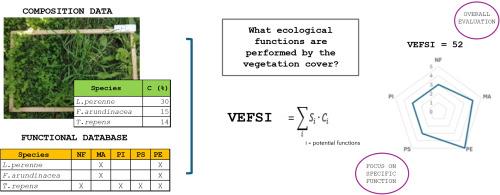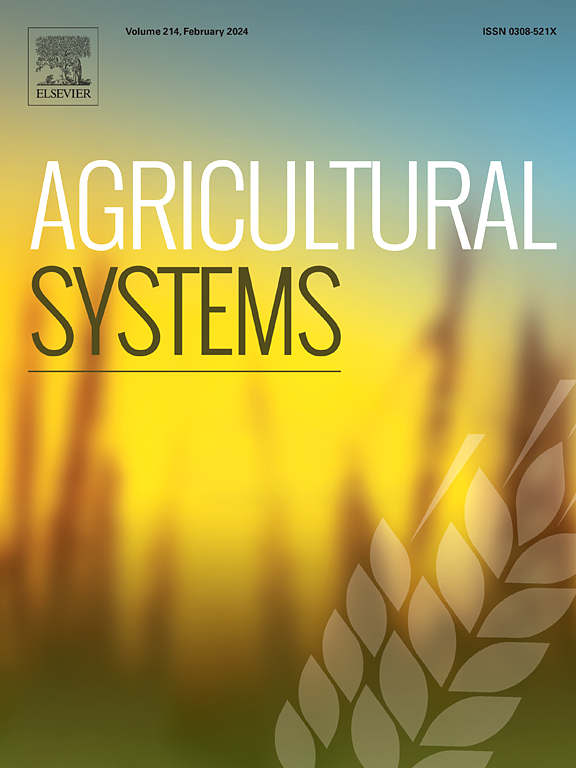优化果园生态系统服务的植被生态功能可持续性指数(VEFSI)
IF 6.1
1区 农林科学
Q1 AGRICULTURE, MULTIDISCIPLINARY
引用次数: 0
摘要
背景农业部门日益感到需要量化农业的可持续性及其提供的生态系统服务。指标和指数是实现这一目的的有用工具,但目前在专门的水果种植领域还很缺乏。此外,还需要对果园系统有更全面的认识,同时考虑到非生产性空间,如行间空间,在这些空间中可以采用技术来改善对气候变化的适应。为了填补这一空白,我们开发了 VEFSI(基于植被的生态功能可持续性指数),这是一种多功能指数,可供技术人员、研究人员和农民用于确定果园行间草覆盖的质量,以增加其提供的生态系统服务。每条记录都包括物种丰富度、植被总覆盖率和每个检测到的物种的相对覆盖率。VEFSI 的设计包括不同的生态功能,如固氮、簇生根的机械作用、多年生器官对土壤的覆盖、果树授粉服务以及吸引授粉者的多花树种。结果与结论发现,VEFSI、植被覆盖度(R2 = 0.419;P <;0.001)和物种数量(R2 = 0.53;P <;0.001)之间存在正相关关系。在测试的数据集中,没有达到 125 的最大理论值,这表明各功能之间存在权衡。尽管如此,验证结果表明,VEFSI 指出了植被的功能弱点和优势,与实际情况一致。事实证明,VEFSI 是估算和评估果园植草生态功能的简单而可靠的工具。本文章由计算机程序翻译,如有差异,请以英文原文为准。

Vegetation-based Ecological Functions Sustainability Index (VEFSI) for optimizing ecosystem services in orchards
CONTEXT
The need to quantify sustainability in agriculture and the ecosystem services it provides is increasingly felt by the sector. Indicators and indices are useful tools for this purpose, but are currently scarce in the specialized fruit-growing sector. In addition, there is a need for a more holistic view of the orchard system, which also considers unproductive spaces, such as the inter-row, where techniques can be implemented to improve adaptation to climate change.
OBJECTIVES
To help filling this gap, we developed VEFSI (Vegetation-based Ecological Functions Sustainability Index), a multifunctional index that can be used by technicians, researchers and farmers to establish the quality of grass cover in the orchard's inter-row in order to increase the ecosystem services performed by this.
METHODS
A dataset of field observation was collected during the year 2022–2023 in orchards located in South-West Piedmont (Northern Italy). Each record included observations on species richness, total vegetation cover and relative cover of each detected species. VEFSI was designed to include different ecological functions, such as nitrogen fixation, mechanical action performed by fascicled roots, soil cover performed by perennial organs, pollination service of the fruit crop and melliferous species for pollinator attraction. The index was calculated as a sum of scores attributed to single functions on the basis of the relative abundance of plants characterized by the corresponding functional traits.
RESULTS AND CONCLUSION
A positive relation has been found among VEFSI, vegetation cover (R2 = 0.419; P < 0.001) and number of species (R2 = 0.53; P < 0.001). Within the tested dataset the maximum theoretical value of 125 has not been reached, indicating trade-offs presence among functions. Despite this, the validation showed that VEFSI point out functional weaknesses and strengths of the vegetation covers, coherently with the real field situation. VEFSI proved to be a simple and reliable tool for estimating and evaluating ecological functions performed by orchard grassing.
求助全文
通过发布文献求助,成功后即可免费获取论文全文。
去求助
来源期刊

Agricultural Systems
农林科学-农业综合
CiteScore
13.30
自引率
7.60%
发文量
174
审稿时长
30 days
期刊介绍:
Agricultural Systems is an international journal that deals with interactions - among the components of agricultural systems, among hierarchical levels of agricultural systems, between agricultural and other land use systems, and between agricultural systems and their natural, social and economic environments.
The scope includes the development and application of systems analysis methodologies in the following areas:
Systems approaches in the sustainable intensification of agriculture; pathways for sustainable intensification; crop-livestock integration; farm-level resource allocation; quantification of benefits and trade-offs at farm to landscape levels; integrative, participatory and dynamic modelling approaches for qualitative and quantitative assessments of agricultural systems and decision making;
The interactions between agricultural and non-agricultural landscapes; the multiple services of agricultural systems; food security and the environment;
Global change and adaptation science; transformational adaptations as driven by changes in climate, policy, values and attitudes influencing the design of farming systems;
Development and application of farming systems design tools and methods for impact, scenario and case study analysis; managing the complexities of dynamic agricultural systems; innovation systems and multi stakeholder arrangements that support or promote change and (or) inform policy decisions.
 求助内容:
求助内容: 应助结果提醒方式:
应助结果提醒方式:


